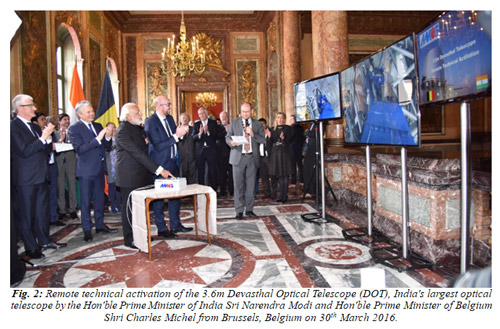 Aryabhatta Research Institute of Observational Sciences (ARIES), a research institute based in the pristine hilly ambience of Nainital, houses three optical telescope and focuses its research on Astronomy & Astrophysics, atmospheric and engineering sciences. The Astronomy and Astrophysics division concentrates on solar, planetary, stellar, galactic, and extra-galactic astronomy, including stellar variabilities, X-ray binaries, star clusters, nearby galaxies, quasars, and inherently transient events like supernovae and highly energetic gamma-ray bursts.
Aryabhatta Research Institute of Observational Sciences (ARIES), a research institute based in the pristine hilly ambience of Nainital, houses three optical telescope and focuses its research on Astronomy & Astrophysics, atmospheric and engineering sciences. The Astronomy and Astrophysics division concentrates on solar, planetary, stellar, galactic, and extra-galactic astronomy, including stellar variabilities, X-ray binaries, star clusters, nearby galaxies, quasars, and inherently transient events like supernovae and highly energetic gamma-ray bursts.
The unique position of ARIES (79° East) places it at almost in the middle of 180° wide longitude band, between Canary Island (20° West) and Eastern Australia (157° East) provides longitudinal advantage for astronomical observations. Unique contributions from the past include the first successful Indian optical observations of the afterglow of gamma-ray burst on January 23, 1999, a few micro-lensing events and quasar variability, discovery of new ring systems around Saturn, Uranus, and Neptune. Several notable contributions in the field of observational astronomy and astrophysics towards Galactic and extra-galactic celestial objects are recognized by using data taken from facilities at ARIES. Moreover, to strengthen the scientific contribution, the Institute has extended its horizon to theoretical and numerical studies in Relativistic Astrophysics. Research focus in Atmospheric Sciences division is mainly in the lower part of the atmosphere and covers the studies on aerosols and trace gases.
ARIES is an autonomous institute under the Department of Science and Technology (DST), Govt. of India. It came into existence at Varanasi in 1954 with the name U.P. State Observatory and was shifted to Nainital in 1956. Since 22 March 2004, the institute is funded by the DST. To build and operate state-of-the-art observational facilities in related subject areas are also an integral part of the research and developmental activities of ARIES.
 The 104-cm optical telescope is being used as the main observing facility by ARIES scientists since 1972 for stellar observations along with the 15-cm solar tower telescope dedicated for solar observations at Manora peak. In order to carry out observations in the frontier areas of astronomy considering longitudinal advantage of India, the Institute has recently installed 130-cm and 360-cm optical telescopes at a site called 'Devasthal' at a distance of ~ 60-Km from ARIES, which has the advantages of having dark skies and excellent observing conditions. There are different instruments for observation of physical and optical properties of aerosols, trace gases, and to study regional environment, particularly interactions between natural and anthropogenic trace species and climate changes. An 84-cm micro-pulse LIDAR system for high altitude studies of aerosols and an ST Radar (Stratosphere Troposphere Radar) to measure winds speed up to an altitude of around 20 km has also recently been set up at ARIES.
The 104-cm optical telescope is being used as the main observing facility by ARIES scientists since 1972 for stellar observations along with the 15-cm solar tower telescope dedicated for solar observations at Manora peak. In order to carry out observations in the frontier areas of astronomy considering longitudinal advantage of India, the Institute has recently installed 130-cm and 360-cm optical telescopes at a site called 'Devasthal' at a distance of ~ 60-Km from ARIES, which has the advantages of having dark skies and excellent observing conditions. There are different instruments for observation of physical and optical properties of aerosols, trace gases, and to study regional environment, particularly interactions between natural and anthropogenic trace species and climate changes. An 84-cm micro-pulse LIDAR system for high altitude studies of aerosols and an ST Radar (Stratosphere Troposphere Radar) to measure winds speed up to an altitude of around 20 km has also recently been set up at ARIES.
In the near future, ARIES plans to establish another unique observational facility, namely a 4-meter International Liquid Mirror Telescope (ILMT) at Devasthal, to carry out a survey of the certain part of the sky to very deep limits. Following the strong tradition of solar physics at ARIES, scientists are also involved in national projects like the National Large Solar Telescope (NLST) and Solar Space missions like ADITYA L1. Furthermore, ARIES is participating in one of the mega-sciences projects called Thirty Meter Telescope (TMT) project, and scientists from ARIES have worked on it in collaboration with Nobel laureate Andrez Ghez.






























